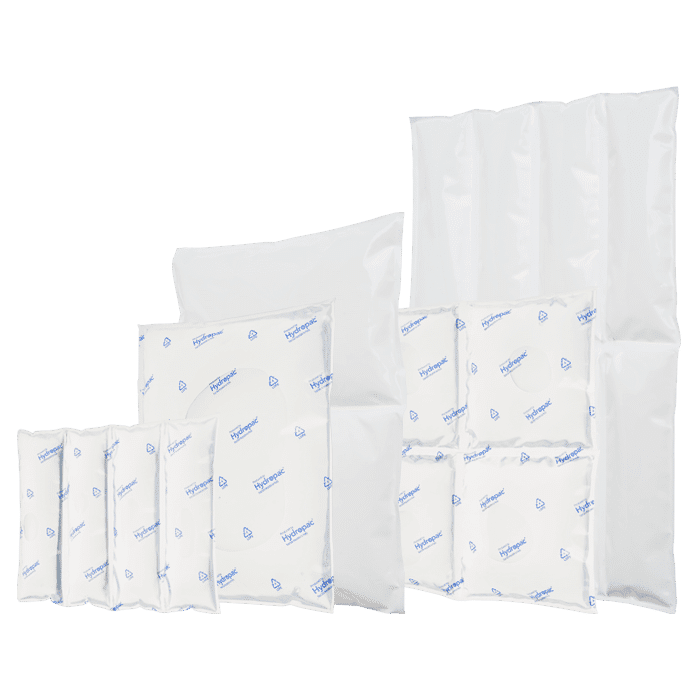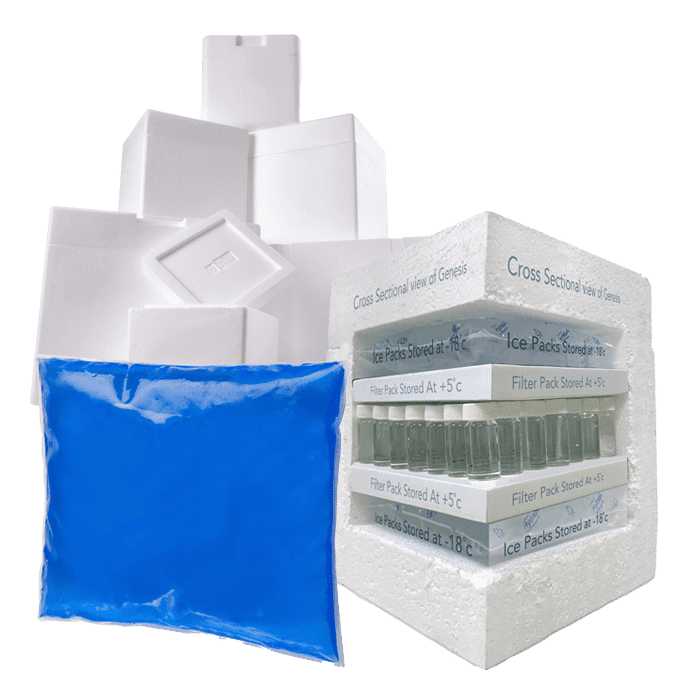Is dry ice the best way to control the temperature of food?
Controlling the temperature of packages is crucial when it comes to shipping temperature sensitive goods, such as pharmaceuticals and food products, but is dry ice actually the best way to control the temperature inside your packages throughout the delivery process?
Dry ice has the ability to control the temperature of packages, but so do water ice packs and gel ice packs. It is important to establish which temperature controlling option is the best for your products and packaging.
Custom chilled solutions for you
Hydropac offers every customer a customized solution for chilled and conditioned shipping. For example, we help a customer with limited freezing capacity to deliver gel packs frozen and ready to use, and we can manufacture almost all shapes and sizes of cooling elements. As a customer, you come first: we are here to help you.
Dry Ice
Dry ice is a solid form of carbon dioxide that sits at a temperature of -79 degrees Celsius. It can stay cold for a very long time and can be a good option for shipping frozen products.
- When dry ice thaws, it does not melt into a liquid, but instead turns back into a gas, so it does not get any products or shipping packaging wet.
- There is no secondary waste when it comes to dry ice because it turns into gas (“sublimation”).
That said, it’s also important to know that dry ice has its downsides.
- It can’t be used to ship items that should remain chilled, because it is too cold and will freeze them.
- Not only that, food shipped with dry ice should be 100% sealed because it can alter the taste and texture of a product.
- Dry ice suffers from natural sublimation as above – extra amounts need to be ordered to account for this.
- Dry ice can also be dangerous to touch without the correct protection and it should never be handled with bare hands. Packages containing dry ice should also have hazard labels applied to the outside to explain to those handling the packaging that it contains a hazardous material.
- There are also more forms to fill out when using dry ice for transport, which can increase the handling charge.
- In recent months there has also been a shortage of dry ice, due to the shortage of carbon dioxide (the gas used to make dry ice). The shortage of CO2 and dry ice has caused big supply issues for lots of businesses that rely on CO2 to keep their products frozen during shipment.
HydroFreeze™ Ice packs
Ice packs, such as those in the HydroFreeze™ range, have the ability to offer a safe way to deliver frozen and chilled goods with none of the negative associations that dry ice brings.
- All of the ice packs in the HydroFreeze™ range are completely food contact safe so will not alter the texture or taste of a food product, unlike dry ice. This also applies to all ice packs in the Hydropac main range of ice packs.
- They are FSA certified food safe, non-toxic and not classed as hazardous goods
- Unlike dry ice, they require no special safety handling guidelines or external labels.
- Multiple variants available, tailored to different needs.
- None of our ice packs suffer from sublimation, unlike dry ice, so you will not need to purchase extra to account for sublimation losses.
- They have a burst strength of over 200kg.
- They can be tailored and printed with a company logo for a professional appearance.
What makes HydroFreeze & EasiFreeze different to dry ice or pure water?
As can be seen by the table above, both HydroFreeze™ and EasiFreeze™ ice packs are suitable for frozen food shipments, they’re reusable, and can hold frozen goods at a minimum temperature of 21°C/-16°C respectively for 24 hours.
In addition, EasiFreeze™ offers shorter freeze times than the HydroFreeze™ ice packs – up to 33% quicker. This means that they can be frozen down and shipped on in quicker time frame. On average, EasiFreeze™ will take twice as long to freeze as a normal water ice pack, and HydroFreeze™ will take three times as long.
Dry Ice vs Ice Pack Comparison
Overall, when handled correctly, dry ice can be a good product to use, but it does have its downsides. In addition, there have been several years of uncertainty in the supply of dry ice and even now, as of 2022, we’re experiencing a nationwide shortage.
Ice packs are beneficial for temperature sensitive products, more cost effective (especially with the CO2 shortage) and ultimately safer for the products and those handling the packaging. Available in both freezer trays and courier boxes,HydroFreeze™ and EasiFreeze™ ice packs give you the benefits of dry ice without the risk.
If you think these sound like the right ice packs to serve you as a safe alternative to dry ice, you can buy online with a low MOQ of 1 pallet or box per order.
If you’re not ready to commit just yet, then why not try a sample of our HydroFreeze™ and/or EasiFreeze™ ice packs for free to help you decide if these are the right packs for you.
- HydroFreeze™ samples: https://hydropac.co.uk/product/hydro-freeze-ice-pack-samples/
- EasiFreeze™ samples: https://hydropac.co.uk/product/easifreeze-ice-pack-samples/
This is a one-time service per customer with up to 3 samples per basket. Just pay postage.
Related Links:
Sustainability Hydropac and CSR
Sustainability isn’t just a trend for us – it’s a promise. As we innovate, create, and lead, we keep our planet’s well-being at the forefront. With Hydropac, you’re not just preserving the quality of your cargo; you’re contributing to a healthier world.
Experience the power of sustainable temperature assurance with Hydropac – where excellence and environmental responsibility coexist for a brighter future.







